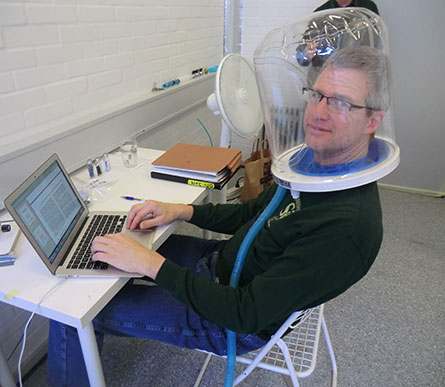Air pollutants enter body through skin
For some semivolatiles such as phthalates, dermal uptake can at least match entry via lungs

MORE THAN SKIN DEEP Some chemicals in products ranging from cosmetics to plastics used in neonatal intensive care units can seep into a person’s body as readily through the skin as via breathing, new studies show.
Martin Valigursky/Shutterstock
For some toxic air pollutants, more can get into the body through the skin than via breathing, new human data indicate.
The natural assumption is that inhalation is the primary route by which air pollutants invade the body. Each breath delivers those chemicals to the blood, which courses through the lungs’ tiniest airways. But the body’s biggest organ is the skin, and recent studies show “that we’re big sponges for these chemicals,” says John Kissel of the University of Washington in Seattle.
Earlier research had suggested that semivolatile compounds — those that move through air in both the gas and condensed phases — tend to pass through skin relatively slowly. “But,” Kissel says, “if the whole body is exposed, then even low rates of exposure can deliver what turns out to be nontrivial amounts of these chemicals.”
One worrisome group of chemicals are semivolatile phthalates, which are used as solvents and building blocks for plastics. Owing to their widespread use, phthalates are found throughout the environment and in people’s bodies. Studies have linked prenatal exposure to phthalates to gonadal and cognitive changes in babies and young children.

Air exposures to phthalates in the Danish tests were high but below limits set for industrial workers. To control for inhalation exposures, participants wore a hood on one day. This allowed them to breathe relatively clean air instead of the room’s phthalate-polluted air. To maximize skin contact with air, each man wore only shorts.
Charles Weschler, an indoor-air chemist at Rutgers University in Piscataway, N.J., led the new trial (and was one of its participants).
For DEP, inhalation and skin transport delivered roughly equal amounts of the pollutant into the blood — and urine. For DnBP, he says, “dermal exposures were about 80 percent as big as inhalation’s.” The researchers report their findings in the October Environmental Health Perspectives.
A six-hour exposure was too brief to allow the phthalates to completely fill a participants’ skin. Until inner skin tissue fills up, only some — not the maximum amount — of the airborne chemicals will make it into a person’s blood. But the researchers’ computations show that had the exposures been extended for another 30 to 40 hours, “then dermal absorption could be five to six times higher than inhalation,” Weschler says.
Another 30 or so common indoor air pollutants should easily enter the body through skin, Weschler and a colleague found in another study. These pollutants include other phthalates, parabens used in sunscreens and cosmetics, nicotine, synthetic musks used in fragrances, pesticides such as 2,4-D and chlorpyrifos, and solvents such as ethylene glycol.
“This study was both elegant and carefully controlled,” says Shanna Swan, a reproductive epidemiologist at Mt. Sinai Hospital in New York City. “It’s exactly what we need to understand all of the possible exposure routes” for pollutants.
The new data may help explain the very high phthalate levels seen in babies treated in neonatal intensive care units (SN: 8/13/05, p. 109), where phthalate-based tubing and plastics have been widely used.
In a second experiment, Glenn Morrison of Missouri University of Science and Technology in Rolla exposed himself to the same conditions as the participants in the Danish trial. But unlike the mostly bare-skinned men in that trial, Morrison wore clean cotton-based clothes for one exposure. For another, he donned clean clothes that had been left in the phthalate-tainted air for nine days before wearing them.
On June 10 in the Journal of Exposure Science and Environmental Epidemiology, he and Weschler’s group reported that freshly laundered clothes reduced his uptake of airborne phthalates compared with the average uptake seen in the earlier trial. However, wearing togs that had been seasoned by exposure to room air (hanging in a closet, for instance) increased Morrison’s exposure over the bare-skinned conditions.
Clean clothes appear to work as a sink, Kissel explains, soaking up the air pollutants before they can reach the skin. That’s good — and bad. “Skin tends to be most permeable when it’s warm and moist,” he says. “So trapping air close to the skin and heating it [by wearing clothes] may enhance the release of contaminants from [the seasoned] clothing.”







